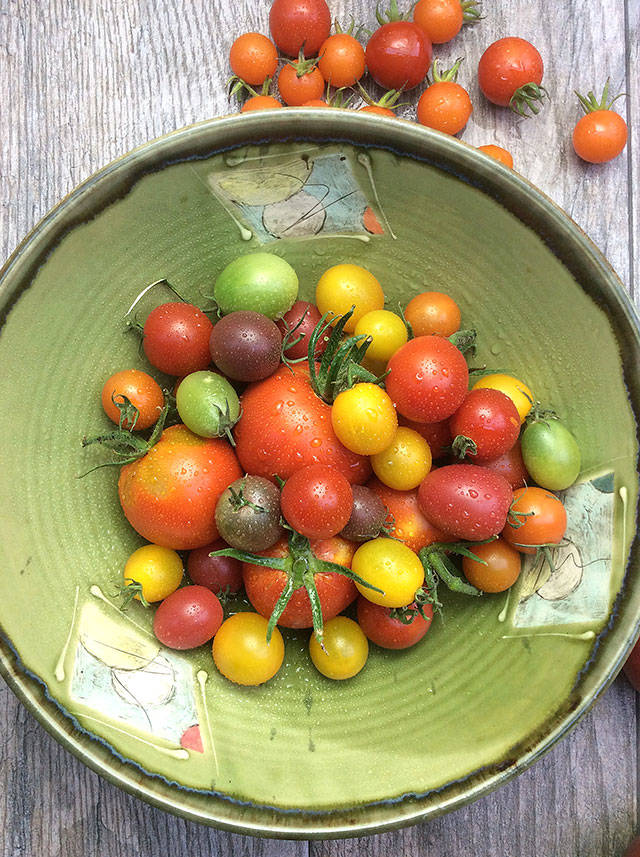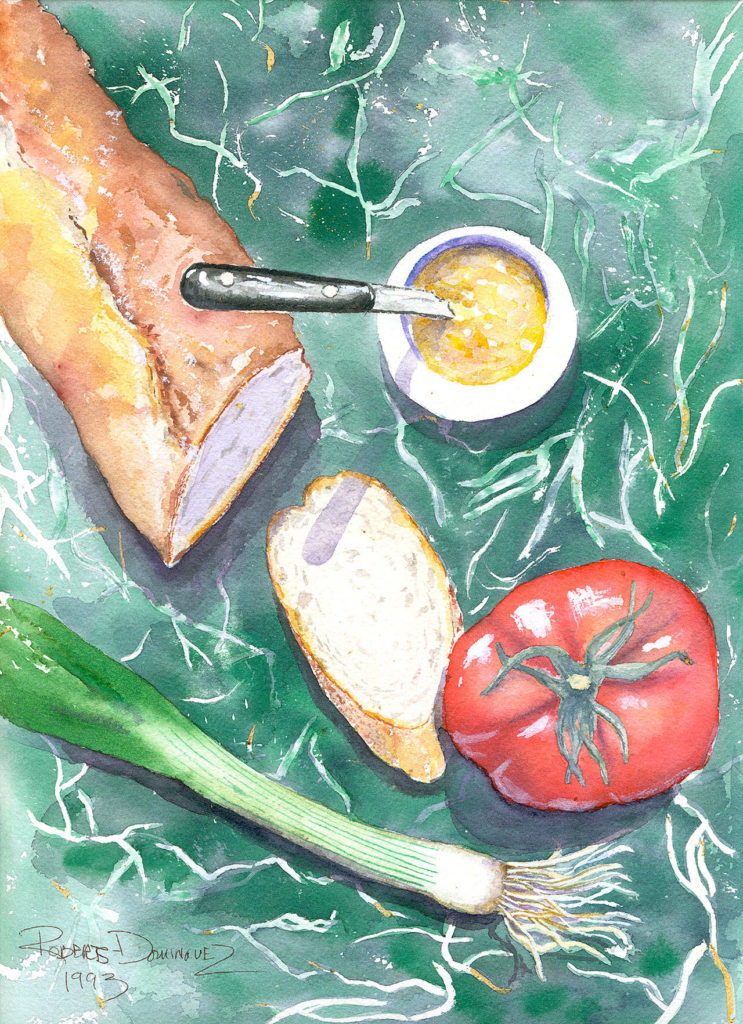It’s time to ready your freezer for summer-into-fall meals.
My summer cache varies slightly from other seasons. We eat lighter, thanks to the local produce, and I tend to make a lot of warm-weather dishes as fajitas, chilled soups, pesto-laced pastas and simple stir-fries.
Even in the last days of summer, I try to keep my freezer well-stocked so that most dinners can be pulled together with little fuss and practically no mess.
As the summer harvest still going strong, I thought I would focus this column on preparing roasted vegetables for fresh eating and the freezer. Here are my thoughts and tips on the subject:
Grill your vegetables. I like to cut a variety of fresh veggies — such as mushrooms, onions, tomatoes, garlic, green beans, squash and eggplant — into like-sizes, brush with a bit of olive oil or marinade and place them in a roasting pan over medium-hot coals. Their flavor and color gets boosted as they cook.
After they have cooled, I pack them into quart-sized freezer bags. Fresh or frozen, they are delicious in tortilla roll-ups and pita bread, or on top of noodles and rice. (They also thaw relatively quickly out of the freezer.)
To peel or not to peel? Tomatoes, that is. It’s up to you. If you plan to puree the mixture once it’s been roasted, then don’t bother dealing with the tomato peels: They’ll disappear once they’ve been subjected to the blender or food processor. Especially if you’re using cherry tomatoes.
Sometimes I like to leave the vegetables in large chunks so I have more dinner options in the months ahead. If I don’t want pieces of peel in the mix, it’s easy to simply pluck them out of the sauce after thawing. But when I do pick them out, I still run those skins through the blender and add them back to the sauce.
Roasted veggies are great for soups and stew starters. When packaging for the freezer, bag them in batches large enough for soups and stews. One of my friends likes to roast and freeze green beans, onion, garlic, basil or rosemary and olive oil for a soup base. She freezes the mix in quart-sized containers and uses them as a divine base for creamy soups all winter long.
For a Southwest style soup: roast corn kernels, chunks of red or green sweet bell pepper, chunks of yellow onion, cloves of garlic, a handful of chopped fresh cilantro, and a healthy sprinkling of cumin powder. Let the mixture cool, and then pack into freezer bags and freeze.
Got a huge sweet red pepper crop this year? Roast up a big batch of them for cream of red pepper soup later on. After roasting, the peels will slip of easily.
Or simply roast whole garlic cloves — don’t be shy! I use at least 2 cups worth — and tomatoes with a bit of olive oil, salt and pepper. The garlic and tomatoes both get tender and sweet in just about the same amount of time and can be used chunky as they come out of the oven, or pureed into a garlicky/tomatoey seasoner. Fresh herbs, such as basil, rosemary or oregano also can be added.
Add some balsamic vinegar during roasting. For an extra zip, glug in a bit of balsamic vinegar as you roast your vegetables. It adds depth and oomph.
I’m providing a recipe for one of my favorite roasting combinations so you can give it a try: Tomatoes, peppers, corn and capers.
The roasting melds everything together, transforms the flavors, and yields juices so delicious they invite dunking with grilled French bread — the perfect summer appetizer. It’s also great served cold as a salad, as a filling for a sandwich or frittata, or a side dish with grilled chicken. And, of course, it freezes beautifully.
Roasted tomatoes, peppers, corn and capers
With its silky texture and summery fragrance, this is one of my favorite dishes to make for summer-into-fall meals.
⅓ cup extra virgin olive oil
2 pounds tomatoes of your choice, peeled (see note)
4 bell peppers, red, orange and yellow
1 Walla Walla sweet onion, peeled, halved and cut into 1-inch chunks
2 ears of sweet corn, kernels cut from the cob
12 Nicoise olives, pitted and coarsely chopped
6 flat-leaf parsley sprigs
12 basil leaves, minced
4 garlic cloves, chopped
2 tablespoons capers, rinsed
Salt and freshly ground pepper to taste
Note: Don’t worry about peeling cherry tomatoes, but larger ones can be peeled before they’re cooked so that you don’t have to deal with the peel after roasting.
To peel, bring a large pot of water to a boil. Meanwhile, cut a shallow X in the bottom of each tomato. Place them in the water just until the skin begins to peel away, about 30 seconds. Remove the tomatoes with a slotted spoon and place in a bowl of ice water.
When they have cooled, halve or quarter each tomato.
Add 2 tablespoons of the olive oil in to a roasting pan, jelly-roll pan or any baking sheet with sides. Add the tomatoes, peppers, onion, corn, olives, parsley, basil, garlic and capers. You can crowd the vegetables together, but don’t go beyond a single layer.
Drizzle the remaining olive oil onto the vegetables, and then sprinkle with salt and pepper to taste. Roast in a 450 degree oven until the tomato skins are turning golden, or about 20 minutes. When done, the tomatoes and peppers will have When done, they will have collapsed and wrinkled.
Alternatively, you can roast the vegetables over indirect heat on your grill, with the lid on. I have a wood pellet-fed grill, which adds a smoky flavor to the vegetables.
Remove the roasting pan from the oven or grill and let the vegetables cool. With a metal or wooden spatula, stir and scrape the cooled mixture to dissolve all of the cooked-on bits of food. Makes 4 cups of roasted vegetable sauce.
To freeze, ladle the sauce into freezer containers, leaving about 1-inch of space at the top. Let cool completely, then attach lids and freeze.
Basic roasted vegetable bisque
When it comes time to start enjoying your roasted vegetable cache, here’s a basic soup recipe from which you can spring-board into all sorts of directions.
4 cups chicken broth (or roasted vegetable broth)
1 cup peeled and diced potato (I prefer Yukon gold)
3 cups roasted vegetable mixture, thawed
1½ cups half-and-half
¼ teaspoon white pepper
Salt to taste
In a large, heavy-bottomed pot, combine the chicken broth with the potato. Cover and simmer until the potato is almost tender but still slightly firm. Add the thawed roasted vegetables and continue cooking, covered, until the potato is very tender. Remove from heat and let cool slightly.
Puree in batches in a blender or food processor. Return the mixture to the pot and stir in half-and-half. Add pepper and salt to taste.
Note: If the roasted vegetable mixture that you’re using doesn’t contain onions or garlic, consider adding some to the pot when cooking the potatoes and broth; the flavor profile will be richer.
Talk to us
> Give us your news tips.
> Send us a letter to the editor.
> More Herald contact information.


























